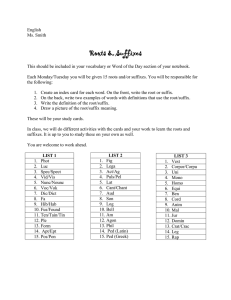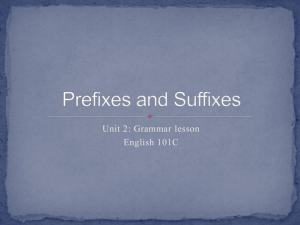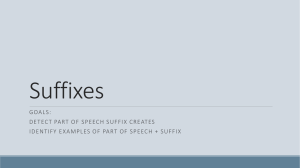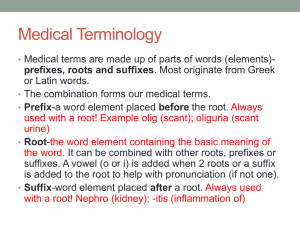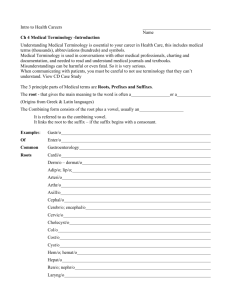Ghosts, Mirrors, and Adversative Passives in Hul’q’umi’num’
advertisement
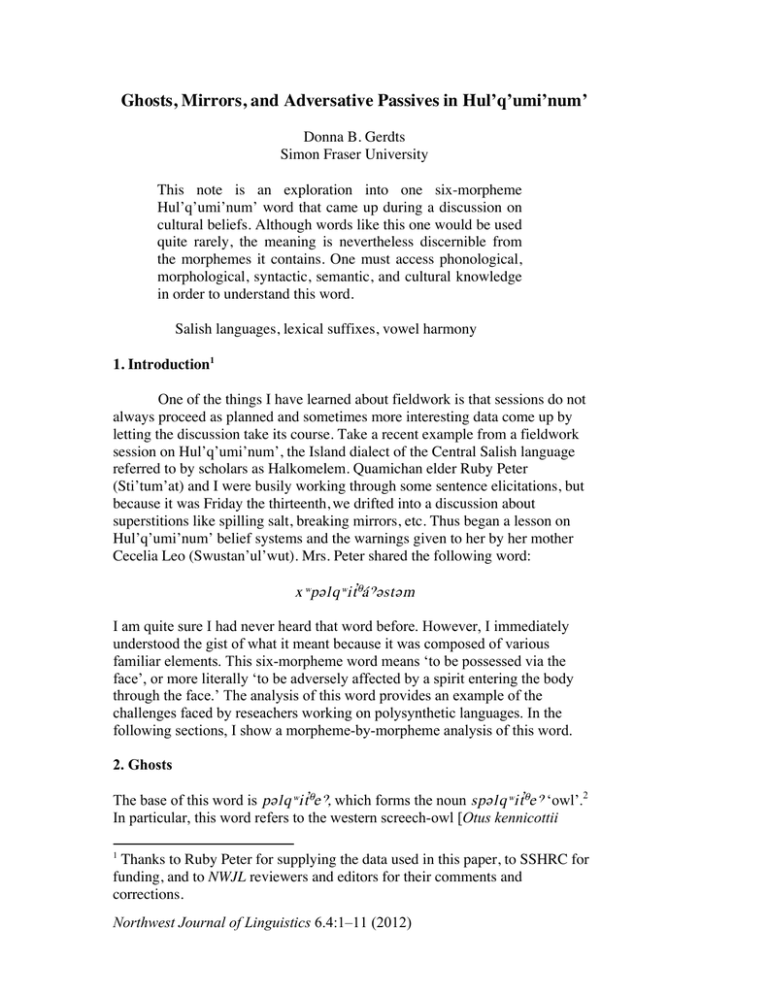
Ghosts, Mirrors, and Adversative Passives in Hul’q’umi’num’ Donna B. Gerdts Simon Fraser University This note is an exploration into one six-morpheme Hul’q’umi’num’ word that came up during a discussion on cultural beliefs. Although words like this one would be used quite rarely, the meaning is nevertheless discernible from the morphemes it contains. One must access phonological, morphological, syntactic, semantic, and cultural knowledge in order to understand this word. Salish languages, lexical suffixes, vowel harmony 1. Introduction1 One of the things I have learned about fieldwork is that sessions do not always proceed as planned and sometimes more interesting data come up by letting the discussion take its course. Take a recent example from a fieldwork session on Hul’q’umi’num’, the Island dialect of the Central Salish language referred to by scholars as Halkomelem. Quamichan elder Ruby Peter (Sti’tum’at) and I were busily working through some sentence elicitations, but because it was Friday the thirteenth, we drifted into a discussion about superstitions like spilling salt, breaking mirrors, etc. Thus began a lesson on Hul’q’umi’num’ belief systems and the warnings given to her by her mother Cecelia Leo (Swustan’ul’wut). Mrs. Peter shared the following word: xøp;lqøi˙á÷;st;m I am quite sure I had never heard that word before. However, I immediately understood the gist of what it meant because it was composed of various familiar elements. This six-morpheme word means ‘to be possessed via the face’, or more literally ‘to be adversely affected by a spirit entering the body through the face.’ The analysis of this word provides an example of the challenges faced by reseachers working on polysynthetic languages. In the following sections, I show a morpheme-by-morpheme analysis of this word. 2. Ghosts The base of this word is p;lqøi˙e÷, which forms the noun sp;lqøi˙e÷ ‘owl’.2 In particular, this word refers to the western screech-owl [Otus kennicottii 1 Thanks to Ruby Peter for supplying the data used in this paper, to SSHRC for funding, and to NWJL reviewers and editors for their comments and corrections. Northwest Journal of Linguistics 6.4:1–11 (2012) 2 (Elliot)], a mottled grey medium-sized owl with ear tufts (Gerdts et al. 1997).3 In Hul’q’umi’num’ culture, as throughout the Pacific Northwest, owls are associated with ghosts and death.4 So this word is also translated as ‘ghost, spirit’. In particular, in the Hul’q’umi’num’ belief system, hearing an owl is considered to be a very bad omen, usually associated with the death of a relative. The root √p;lqø is not identified, but the the word contains a lexical suffix -i˙e÷. Salish languages are well-known for their lexical suffixes, suffixes that contain meanings usually associated with nouns (Gerdts 2003). Hul’q’umi’num’ has over one hundred lexical suffixes referring to body parts and elements of material cultural. According to Hinkson’s (1999) seminal work on five Salish lexical suffixes, the Hul’q’umi’num’ suffix -i˙e÷ is a reflex of the Proto-Salish suffix *iça÷, to which she gives the gloss ‘hide’. This suffix takes on the meaning of ‘blanket’, ‘clothing’, and ‘cloth’ in Hul’q’umi’num’. We see this in Hul’q’umi’num’ in words like ˙≈øi˙e÷ ‘wash clothes’ (cf. ˙≈øat ‘wash it’) and s√pi˙e÷ ‘slip’ (cf. √;p ‘underneath, down below’). 3. Face In the form xøp;lqøi˙a÷;st;m, the stem is suffixed with yet another lexical suffix, -as ‘face’ (Gerdts and Hinkson 2004). The lexical suffix appears as the underlying form -as or -;s depending on stress.5 The suffix appears with a full vowel under stress (1), or otherwise with schwa (2):6 (1) ni÷ √qπ ˚øi÷ l;ç √˙≈ø ‘be there’ ‘be down’ ‘go up’ ‘full’ ‘wash’ n;÷-ás qπ-ás ˚ø;÷-ás l;ç-ás ß-˙≈ø-as ‘facing away’ ‘have one’s face down’ ‘facing up’ ‘full (round object)’ ‘washed face’ 2 For many speakers, this word takes the form sp;p;lqøi˙e÷. CVreduplication is common in animal names, for example sq;q;weƒ ‘rabbit’, m;m;≈e® ‘caterpillar’. Some words vary among speakers and dialects, appearing with and without reduplication, for example p;p;˙i∫ ~ sp;˙i∫ ‘skunk’. 3 Thanks to Brian Compton for helping with work on Hul’q’umi’num’ birds. The association of owls with ghosts or afterlife is prevalent in Native American cultures (cf. Native American Owl Mythology) as well as many cultures world-wide (cf. Animal Allies: Owls and the Afterlife). 5 Bianco (1996) shows that primary stress falls on the first vowel, based on the following sonority hierarchy: /e, a, o, u/ > /i/ > /;/. Since stress is largely predictable in the Island dialect, we do not usually indicate it. 6 The symbol √ is used for verb roots that are not attested as independent words. 4 Northwest Journal of Linguistics 6.4:1–11 (2012) 3 (2) qa÷ qit-;t ®iç √÷i≈ ‘water’ ‘tie it’ ‘cut’ ‘scrape’ ß-qá÷-;s ß-qít-;s xø-®íç-;s-t xø-÷í≈-;s-;m ‘tears (water on face)’ ‘headband’ ‘cut him/her on the face’ ‘scrape one’s face’ In the word xøp;lqøi˙á÷;st;m, the lexical suffix is unstressed and thus it appears as -;s. As noted by Hukari and Peter (1995:371ff.), several Hul’q’umi’num’ suffixes with an underlying a trigger vowel harmony e > a on a preceding vowel. 7 This is seen, for example, in the following data involving the lexical suffix -a÷qø ‘head’; in the following examples, the transitive suffix –t indicates that action is done to a third person and the middle suffix –m indicates that it was done to oneself.8 (3) ˚øes πe√-;t ‘burn’ ‘feel it’ ˚øas-a÷qø πaπ;√-a÷qø-t ‘scorched head’ ‘feeling his/her head’ We see that the lexical suffix -as also triggers vowel harmony on a preceding e: (4) ˚øes ÷e˙-;t πe√-;t ≈†e˚ø ‘burn’ ‘wipe it’ ‘feel it’ ‘carve’ xø-˚øas-;s xø-÷a˙-;s-;m xø-πa√-;s-t xø-≈†a˚ø-;s-t ‘burned face’ ‘wipe one’s face’ ‘feel his/her face’ ‘carve a mask’ In the word xøp;lqøi˙á÷;st;m, we see that the lexical suffix -i˙e÷ surfaces as -i˙a÷ due to vowel harmony with the suffix -as ‘face’. The lexical suffix has a much broader set of meanings, including round objects, the moon, and money. But when it carries the meaning of ‘face’, it is usually accompanied by the lexical prefix xø-. 9 (5) a. xø-®aœø-;s-t LOC-slap-face-TR ‘slap him/her on the face’ 7 Suttles (2004) also notes this effect and calls it umlaut. The following abbreviations are used for glossing the data: 1 first person, 2 second person, 3 third person, AUX auxiliary, CONJ conjunction, CN connective, DEP dependent clause, DET determiner, FUT future, LNK linker, LOC locative prefix, NM nominal, MID middle, OBJ object, OBL oblique, PAS passive, PL plural, POS possessive, Q question, RES resultative, SG singular, ST stative, SUB subject, TR transitive. 9 Lexical suffixes frequently cooccur with the prefixes s- ‘nominalizer’ and xø‘locative’. When both prefixes occur, the s assimilates to ß- before xø- and xøis deleted before consonants. 8 Northwest Journal of Linguistics 6.4:1–11 (2012) 4 b. xø-®iç-;s-t LOC-cut-face-TR ‘cut someone on the face’ c. xø-†;µ-;s-t LOC-pound-face-TR ‘pound on someone’s face’ d. xø-÷a˙-;s-;m LOC-wipe-face-MID ‘wipe one’s face’ The semantics of this prefix are not well understood, but it often accompanies body part lexical suffixes that are perceived as contained within the body, as opposed to be appended to it. Thus, suffixes for ‘eye’, and ‘throat’ are accompanied by the prefix xø- (6), and suffixes for ‘hand’ or ‘leg’ are not (7): (6) (7) a. xø-x;¬-al;s-;m LOC-mark-eye-MID ‘put on eye make-up’ b. xø-˙œø-al;s-t LOC-strike-eye-TR ‘punch someone in the eye’ c. xø-ç;¥xø-;q;n LOC-dry-throat ‘thirsty’ d. xø-l;m-q;-t LOC-look-throat-TR ‘look down someone’s throat’ a. ®;ç-c;s cut-hand ‘cut one’s hand’ b. l;kø-ßen break-foot ‘break one’s foot/leg’ c. l;kø-;¬-e≈;∫ break-CN-arm ‘break one’s arm’ Northwest Journal of Linguistics 6.4:1–11 (2012) 5 d. √;lqt-;¬-e≈;∫ long(PL)-CN-arm ‘long sleeves’ One other property concerning the derivational properties of lexical suffixes is relevant to the word xøp;lqøi˙a÷;st;m. We often find that nouns that are not derived further appear with nominal inflection marked by the prefix s-. However, in words that have further derivation, for example lexical suffixes, sometimes no nominal inflection appears. For from sli:m ‘sandhill crane’ is formed lim;s ‘April (i.e. month of the sandhill crane)’. Thus, given the claim that xøp;lqøi˙a÷;s- is based on the form sp;lqøi˙e÷ plus the lexical suffix -as, it is unsurprising that no s- nominal prefix appears in xøp;lqøi˙a÷;st;m. In sum, we see that the word xøp;lqøi˙a÷;st;m contains the lexical suffix for ‘face’, and this locates the avenue of the “ghosting” of the person. As noted by Gerdts and Hinkson (2004), many forms with the lexical suffix ‘face’ describe actions that are directed toward the entire person, as seen in the examples in (8). (8) a. ˚ø®-as-t spill-face-TR ‘throw liquid on him/her’ b. √;÷-as-t go.for-face-TR ‘go pick him/her up’ c. ÷;mß-as-;m walk-face-MID ‘travel, sightsee, tour’ d. xø-ƒœø-as-t LOC-be.adjacent-face-TR ‘meet him/her, go towards him/her’ Similarly, our word xøp;lqøi˙a÷;st;m may exemplify a meronymic use of ‘face’ since possession by a ghost pertains to the entire body. 4. Adversative passives In terms of its morphosyntax, xøp;lqøi˙a÷;st;m is passive. We can see the argument structure of the word in the following example: (9) ni÷ xø-p;lqøi˙a÷-;s-t-;m ƒ; LOC-ghost-face-TR-PAS DET ‘The child was possessed via her face.’ AUX Northwest Journal of Linguistics 6.4:1–11 (2012) s√i÷√q;®. child 6 Main clause passives affecting a third-person patient are formed with the transitive suffix –t followed by the passive suffix -;m.10 Compare, for example the following active and passive clauses. (10) (11) ni÷ ®; AUX çew-;t-;s køƒ;-n; si¬; help-TR-3SUB DET-1SG.POS grandparent ‘My grandfather helped the woman. DET s®eni÷. woman ni÷ çew-;t-;m ÷; køƒ;-n; si¬; ®; s®eni÷. AUX help-TR-PAS OBL DET-1SG.POS grandparent DET woman ‘The woman was helped by my grandfather.’ Hul’q’umi’num’ is fairly unusual cross-linguistically in marking both a transitive and an intransitive layer of inflection in passives. Another unexpected feature of Hul’q’umi’num’ passive inflection is that the subject of the passive is marked with unique inflection that is historically related to object, and not subject, marking (Gerdts and Hukari 2001). This can be seen, for example, by comparing the first-person object suffix in (12) with the first-person passive suffix in (13). (12) ni÷ çew-;ƒaµ-;s køƒ;-n; AUX help-TR.1SG.OBJ-3SUB DET-1SG.POS ‘My grandfather helped me.’ (13) ni÷ si¬;. grandparent çew-;ƒel;m ÷; køƒ;-n; si¬;. help-1SG.PAS OBL DET-1SG.POS grandparent ‘I was helped by my grandfather.’ AUX The inflectional paradigms for active versus passive is illustrated in Table 1. Table 1. Active and passive of çew;t ‘help’ object passive lst person sg. çew-;ƒaµß çew-;ƒel;m 2nd person sg. çew-;ƒam; çew-;ƒa:m lst person pl. çew-;ta¬xø 2nd person pl. çew-;tal; 3rd person çew-;t çew-;tal;m çew-;t;m 10 See Gerdts and Hukari (2006b) for a discussion of the suffix -m ‘middle voice’, including a comparison of its use in passives versus other constructions. Northwest Journal of Linguistics 6.4:1–11 (2012) 7 Since the morphophonology found in the passive is distinctive, we can easily see that the word under study is inflected for passive by examining the full paradigm. Table 2. Passive paradigm of xøp;lqøi˙a÷;st;m passive lst person sg. xøp;lqøi˙a÷;sƒel;m 2nd person sg. xøp;lqøi˙a÷;sƒa:m lst person pl. 2nd person pl. 3rd person xøp;lqøi˙a÷;stal;m xøp;lqøi˙a÷;st;m The form xøp;lqøi˙a÷;sƒel;m means ‘I was possessed via my face’, etc. The inflectional morphology also helps us distinguish our analysis from another potential parsing of xøp;lqøi˙a÷;st;m, in which -st;m is the passive form of the causative, as in ÷;¥st;m ‘it is liked’ (from ÷;¥ ‘good’ plus causative).11 Table 3 gives the active and passive voice inflection for the causative verb. Table 3. Active and passive of ÷;¥st;xø ‘like’ object passive lst person sg. ÷;¥-staµß ÷;¥-stel;m 2nd person sg. ÷;¥-stam; ÷;¥-sta:m lst person pl. ÷;¥-sta¬xø 2nd person pl. ÷;¥-stal; 3rd person ÷;¥-st;xø ÷;¥-stal;m ÷;¥-st;m We see by comparing the first-person singular passive in Table 2 with those in Table 1 and Table 3, that xøp;lqøi˙a÷;sƒel;m is a passive of a transitive and not a causative form. That is, it is not *xøp;lqøi˙a÷;stel;m. The same pertains for the second-person singular passive. Therefore, our parsing of -;s as the unstressed version of the suffix for 'face, followed by the passive –t;m is the correct one. 11 See Gerdts and Hukari (2006a) for a discussion of Hul’q’umi’num’ causatives. Northwest Journal of Linguistics 6.4:1–11 (2012) 8 Another property of the word xøp;lqøi˙a÷;st;m also identifies it as a passive form, namely that it does not have a corresponding active form: (14) xø-p;lqøi˙a÷-;s-t-;s ƒ; s√i÷√q;®. AUX LOC-ghost-face-TR-3SUB DET child Intended meaning: ‘It possessed the child via her face.’ *ni÷ There is a small set of adversative constructions in Hul’q’umi’num’ that have a special property: they always appear as an agentless passive, never as an active (Kiyosawa and Gerdts 2010). Thus, ®;m;xø ‘rain’ forms an adversative passive ®;m;xøt;m ‘to get rained on’, as in (15), but there is no corresponding transitive form *®;m;xøt ‘to rain on it’.12 (15) ni÷ ®;m;xø-t-;m køƒ;-n; ≈;≈ƒ;m ni÷ s-÷e÷√q. AUX rain-TR-PAS DET-1SG.POS box(PL) AUX ST-outside(RES) ‘My boxes that were outside got rained on.’ The verb for ‘get drowsy’, exemplified in (16), is another instance of an adversative passive with no active counterpart (*c;t≈øt): (16) c;t≈ø-ƒa:m ce÷ drowsy-TR.2SG.PAS FUT ÷; ÷;Σ ni:xø LNK AUX.2DEP.SUB m;œ full ƒ; ≈ixø;. OBL DET sea.urchin ‘You’re going to get drowsy when you get full of sea urchin.’ Some adversative passives are formed from nouns. For example ˚ø;¬; ‘stomach’ forms the adversative passive ˚ø;¬;t;m ‘get diarrhea’. Also, some adversative passives are formed on bases containing lexical suffixes, for example œ;lœ;lπn;ct;m ‘get a cramp’ from the root √œ;lπ ‘bend, twist’ and the lexical suffix –n;c ‘bottom’. The following examples illustrate other passives formed on bases containing lexical suffixes: (17) ÷i ƒima÷-ß;-ƒel;m. AUX ice-foot-1SG. PAS ‘My feet are frozen.’ (18) ÷i: ƒima÷-c;s-ƒa:m? AUX.Q ice-hand-1SG.PAS ‘Are your hands frozen?’ 12 Many adversative passives are formed with an applicative suffix (Gerdts and Kiyosawa 2005). Northwest Journal of Linguistics 6.4:1–11 (2012) 9 Thus, we see that the word xøp;lqøi˙a÷;st;m fits the pattern of an adversity passive formed on a base containing a lexical suffix. 5. Mirrors Mrs. Peter is in the habit of illustrating the meaning of a word by putting it in the context of a sentence, and this is the example she used to teach me the word discussed here: (19) ≈ø;m ÷i÷ can CONJ xø-p;lqøi˙a÷-;s-t-;m LOC-owl-face-TR-PAS ÷;w’ ni:s LNK AUX.3DEP.SUB ÷; køs OBL DET.NM ƒ; DET s√i÷√q;® child xøi:¬m-as-;m examine-face-MID xø;ne÷;nt-s. evening-3POS ‘A little girl can get possessed if she looks in the mirror when it’s evening.’ When I heard Mrs. Peter’s illustrative sentence, the meaning of the word xøp;lqøi˙a÷;st;m became very clear. The verbxøi:¬mas;m means to look at ones face in a mirror. The oblique nominalization of this verb (ßxøi:¬mas;m) is used by some speakers as the word for ‘mirror’. The conduit for the possession was thus a mirror. Note that this verb and the word for ‘mirror’ also contain the lexical suffix -as ‘face’. The word for evening is the inchoative imperfective form of √net (cf. snet ‘night’ and net-;® night-past –‘morning’). Thus, xø;ne÷;nt literally means ‘it’s getting to be night’. When darkness falls in Hul’q’umi’num’ territory of course depends upon the time of year, but, when I asked Mrs. Peter at what time of day did mirrors become dangerous, she said that one should stop using the mirror around 3PM during the winter, just to be safe. As one would expect for a deeply spiritual culture, there are other beliefs associated with darkness. For example, it is dangerous to eat outside after dark, and, of course, it is unsafe for young ladies to be out walking around after dark. 6. Conclusion Mrs. Ruby Peter has worked since she was a teen-ager as a translator, consultant, transcriber, researcher, teacher, and spiritualist. In aid of documenting her language, she has spent countless hours probing her memory and coming up with words and illustrative sentences, often pulling from her experiences growing up in a family where Hul’q’umi’num’ was used daily. I often joke with her that she is living her life twice—once for real and once for Northwest Journal of Linguistics 6.4:1–11 (2012) 10 the recorder. The work is not always easy, even though Mrs. Peter loves her language and has dedicated much of her life to speaking, reading, and writing it. This is because the memories are not always pleasant. For example, a recent story she recorded and transcribed concerned the brutal way her father was treated when he had tuberculosis. Many times though, the memories are of a happy Hul’q’umi’num’-speaking family steeped in tradition but embracing the changes around them. Mrs. Peter takes special care in remembering the sn;w’;y;® (spiritual teachings) passed to her by her mother This particular Friday the thirteenth turned out to be a lucky day. Hearing an unfamiliar word was a reminder to me to not assume that the work of lexicography on a language is ever complete. As an outsider, I can only get a glimpse at the cultural significance of a word, which often gets lost in translation. Words like these remind me that language cannot be separated from culture. Also, I am reminded how lucky I am that Mrs. Peter is willing to try to educate me. Not only did Mrs. Peter talk about this belief of her mother’s, but the conversation then turned to what happens when someone gets possessed, and what can be done to rid a person of the possession. But we will leave her telling of this to a more appropriate place and time. ni÷ ne:x;∫ køƒ; n; sqøal. ni÷ hay. ‘That’s the end of my speech. The end.’ References Animal Allies: Owls and the Afterlife. On ‘Walking with Ancestors’ website. http://walkingwithancestors.blogspot.ca/2012/11/animal-allies-owls-andafterlife.html). Accessed on September 1, 2012. Bianco, Violet M. 1996. The role of sonority in the prosody of Cowichan. M.A. Thesis, University of Victoria. Gerdts, Donna B. 2003. The morphosyntax of Halkomelem lexical suffixes, International Journal of American Linguistics 69.4:345–356. Gerdts, Donna B., with Brian Compton, Leonard Edwards, and Charles Ulrich. 1997. Hu¬œumí∫uµ Words: An English-to-Hu¬œumí∫uµ and Hu¬œumí∫uµ-to-English Dictionary. Prepared for the Chemainus, Nanaimo, and Nanoose First Nations and Nanaimo School District No. 68. Gerdts, Donna B., and Mercedes Q. Hinkson. 2004. The Grammaticalization of Halkomelem FACE into a dative applicative suffix,” International Journal of American Linguistics 70.3: 227–250. Gerdts, Donna B., and Thomas E. Hukari. 2001. Argument linking and passives in Halkomelem, Papers for the 36th International Conference on Salish and Neighbouring Languages, University of British Columbia Working Papers in Linguistics 6:113–144. Northwest Journal of Linguistics 6.4:1–11 (2012) 11 Gerdts, Donna B., and Thomas E. Hukari. 2006a. Classifying Halkomelem causatives, Papers for the 41st International Conference on Salish and Neighbouring Languages, University of British Columbia Working Papers in Linguistics 18:129–145. Gerdts, Donna B., and Thomas E. Hukari. 2006b. The Halkomelem middle: A complex network of constructions, Anthropological Linguistics 48.1:44– 81. Gerdts, Donna B., and Kaoru Kiyosawa. 2005. Halkomelem psych applicatives, Studies in Language 29.2:329–362. Hinkson, Mercedes Quesney. 1999. Salishan Lexical Suffixes: A Study in the Conceptualization of Space. Ph.D. dissertation, Simon Fraser University, British Columbia. Hukari, Thomas E. (editor), and Ruby Peter (associate editor). 1995. The Cowichan Dictionary of the Hul’qumi’num’ Dialect of the Coast Salish People. Duncan, Canada: Cowichan Tribes. Kiyosawa, Kaoru, and Donna B. Gerdts. 2010. Benefactives and malefactives in Salish languages, in Fernando Zúñiga and Seppo Kittilä, eds. Benefactives and Malefactives: Typological Perspectives and Case Studies, pp. 147–184. Amsterdam: J. Benjamins. Native American Owl Mythology. http://www.native-languages.org/legendsowl.htm. Accessed on September 1, 2012. Suttles, Wayne. 2004. Musqueam Reference Grammar. Vancouver, British Columbia: UBC Press. Northwest Journal of Linguistics 6.4:1–11 (2012)
